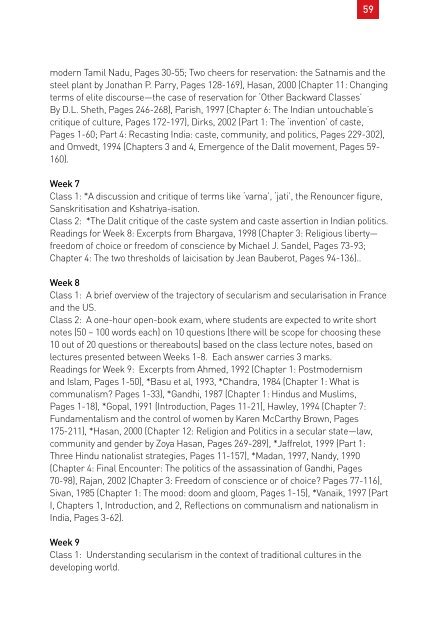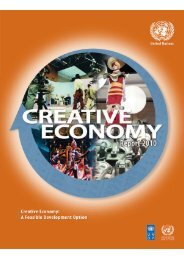Model curricula for journalism education for developing countries ...
Model curricula for journalism education for developing countries ...
Model curricula for journalism education for developing countries ...
Create successful ePaper yourself
Turn your PDF publications into a flip-book with our unique Google optimized e-Paper software.
59<br />
modern Tamil Nadu, Pages 30-55; Two cheers <strong>for</strong> reservation: the Satnamis and the<br />
steel plant by Jonathan P. Parry, Pages 128-169), Hasan, 2000 (Chapter 11: Changing<br />
terms of elite discourse—the case of reservation <strong>for</strong> ‘Other Backward Classes’<br />
By D.L. Sheth, Pages 246-268), Parish, 1997 (Chapter 6: The Indian untouchable’s<br />
critique of culture, Pages 172-197), Dirks, 2002 (Part 1: The ‘invention’ of caste,<br />
Pages 1-60; Part 4: Recasting India: caste, community, and politics, Pages 229-302),<br />
and Omvedt, 1994 (Chapters 3 and 4, Emergence of the Dalit movement, Pages 59-<br />
160).<br />
Week 7<br />
Class 1: *A discussion and critique of terms like ‘varna’, ‘jati’, the Renouncer figure,<br />
Sanskritisation and Kshatriya-isation.<br />
Class 2: *The Dalit critique of the caste system and caste assertion in Indian politics.<br />
Readings <strong>for</strong> Week 8: Excerpts from Bhargava, 1998 (Chapter 3: Religious liberty—<br />
freedom of choice or freedom of conscience by Michael J. Sandel, Pages 73-93;<br />
Chapter 4: The two thresholds of laicisation by Jean Bauberot, Pages 94-136)..<br />
Week 8<br />
Class 1: A brief overview of the trajectory of secularism and secularisation in France<br />
and the US.<br />
Class 2: A one-hour open-book exam, where students are expected to write short<br />
notes (50 – 100 words each) on 10 questions (there will be scope <strong>for</strong> choosing these<br />
10 out of 20 questions or thereabouts) based on the class lecture notes, based on<br />
lectures presented between Weeks 1-8. Each answer carries 3 marks.<br />
Readings <strong>for</strong> Week 9: Excerpts from Ahmed, 1992 (Chapter 1: Postmodernism<br />
and Islam, Pages 1-50), *Basu et al, 1993, *Chandra, 1984 (Chapter 1: What is<br />
communalism Pages 1-33), *Gandhi, 1987 (Chapter 1: Hindus and Muslims,<br />
Pages 1-18), *Gopal, 1991 (Introduction, Pages 11-21), Hawley, 1994 (Chapter 7:<br />
Fundamentalism and the control of women by Karen McCarthy Brown, Pages<br />
175-211), *Hasan, 2000 (Chapter 12: Religion and Politics in a secular state—law,<br />
community and gender by Zoya Hasan, Pages 269-289), *Jaffrelot, 1999 (Part 1:<br />
Three Hindu nationalist strategies, Pages 11-157), *Madan, 1997, Nandy, 1990<br />
(Chapter 4: Final Encounter: The politics of the assassination of Gandhi, Pages<br />
70-98), Rajan, 2002 (Chapter 3: Freedom of conscience or of choice Pages 77-116),<br />
Sivan, 1985 (Chapter 1: The mood: doom and gloom, Pages 1-15), *Vanaik, 1997 (Part<br />
I, Chapters 1, Introduction, and 2, Reflections on communalism and nationalism in<br />
India, Pages 3-62).<br />
Week 9<br />
Class 1: Understanding secularism in the context of traditional cultures in the<br />
<strong>developing</strong> world.

















